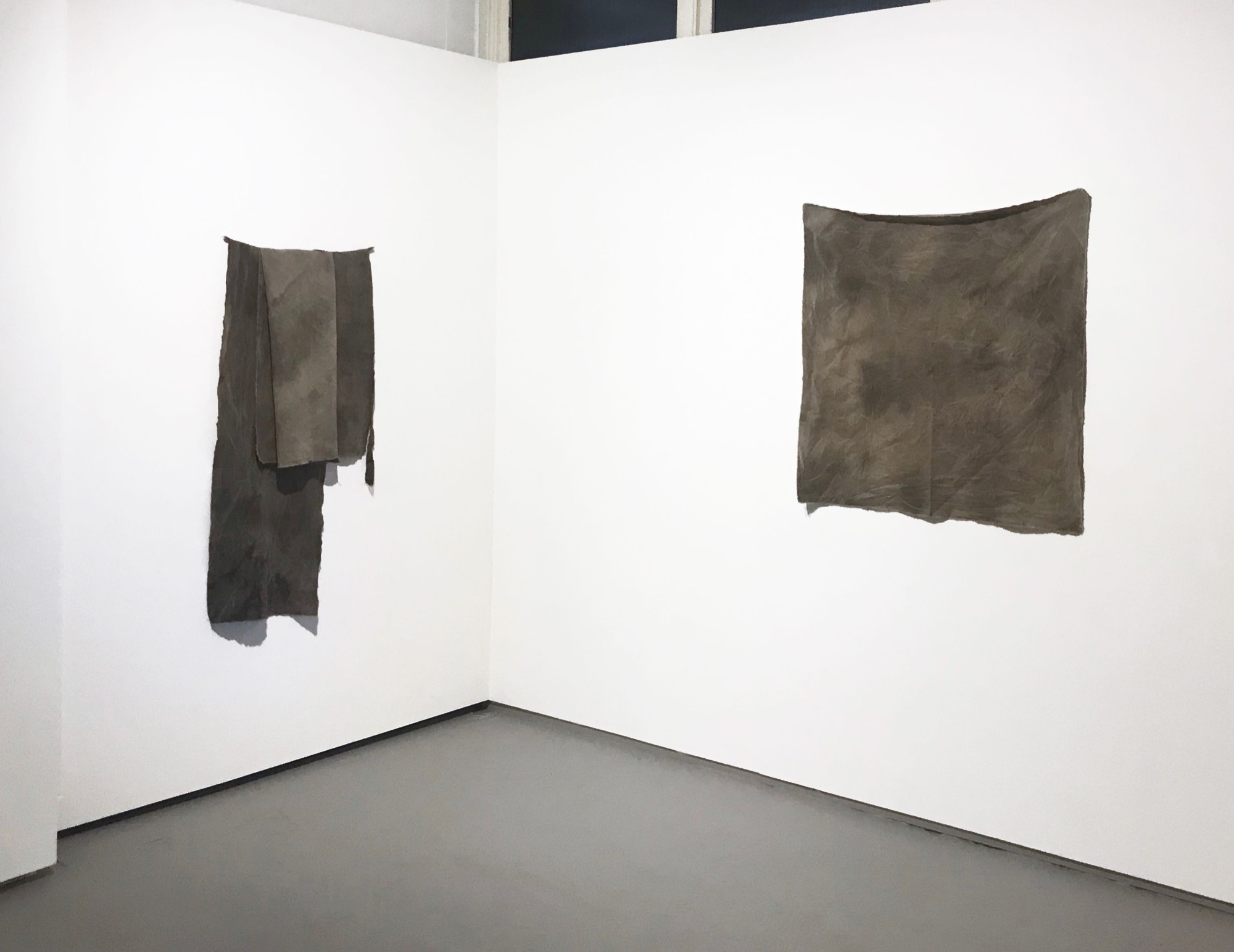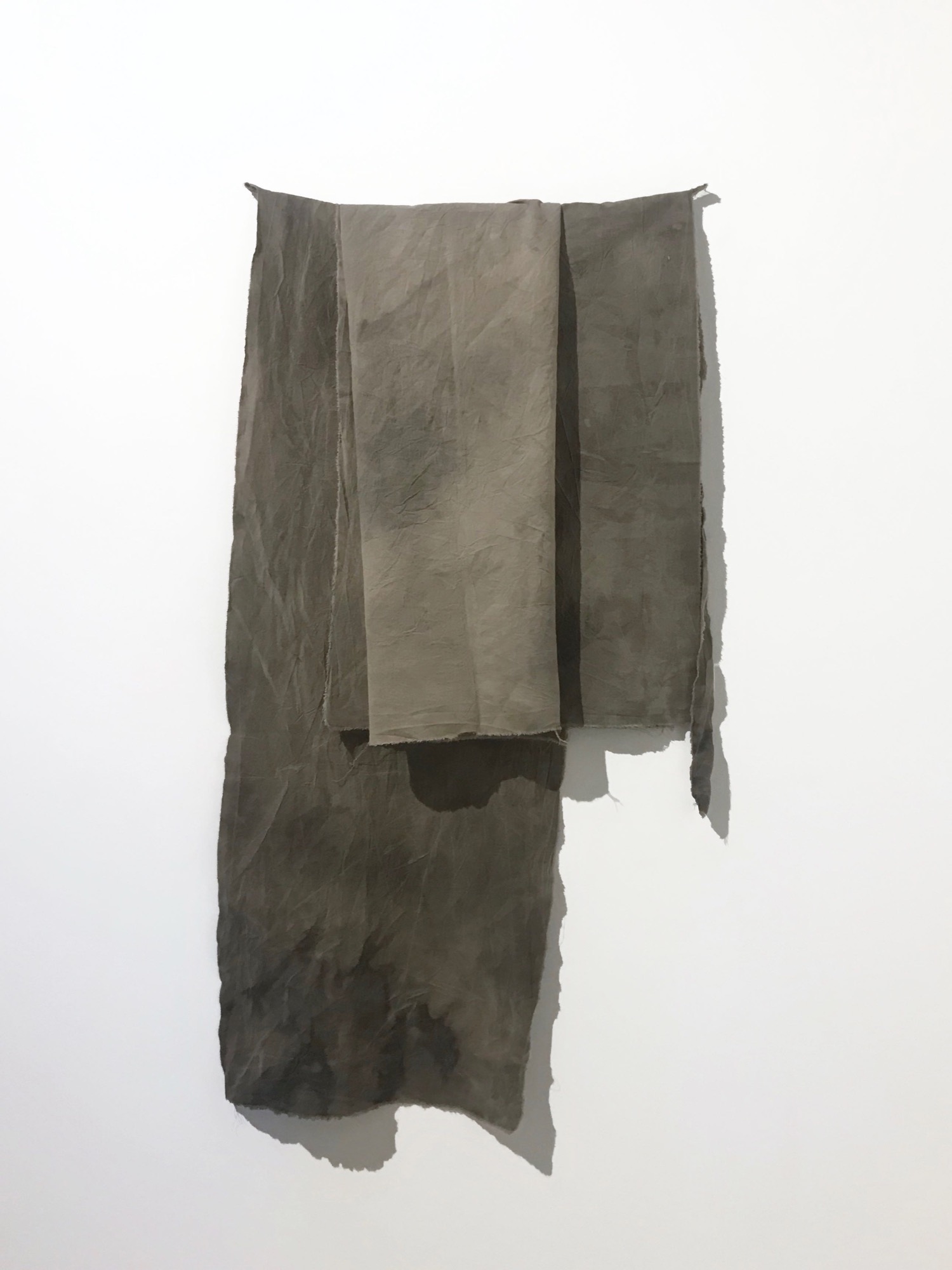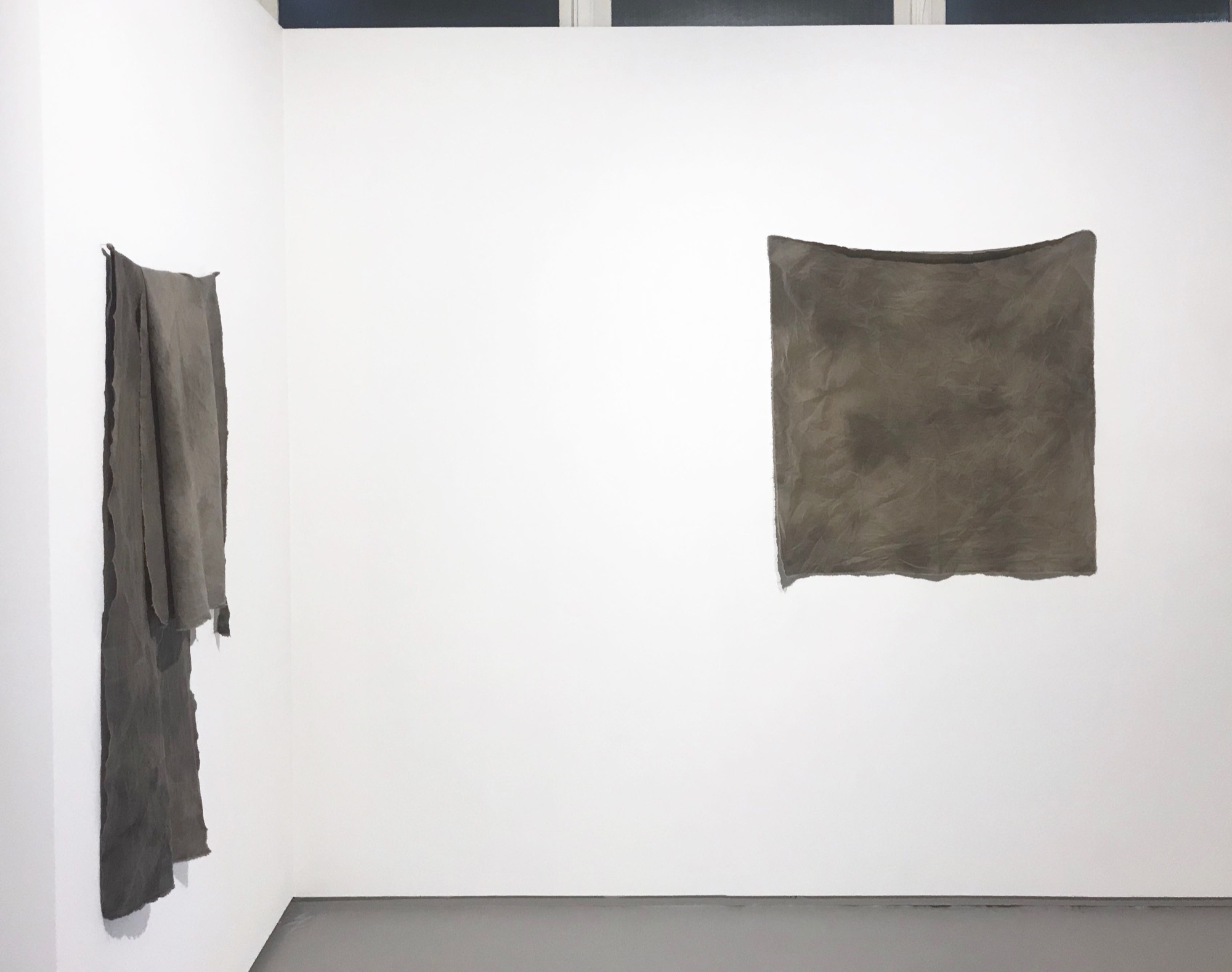Katie West: warna (ground)
Paris Lettau
Warna (ground) is a deceptively small exhibition at the artist-run gallery Caves, located on level 6 of the Nicholas Building on Swanston Street. The space itself measures about four-metres squared. The show comprises three small works, each composed of a piece of canvas that Katie West, a Yindjibarndi woman who grew up in rural Western Australia, has dyed using eucalyptus leaves, bark and flowers she collected, wrapped in the canvas sheets and then placed in a pot of water that boils over a fire. In the room sheet, West suggests that through this process the canvases become infused with the material qualities of the eucalyptus, its colour and scent.
Warna (ground) looks minimalist. Not only because three works are spread relatively sparsely throughout the space, but also because of the exhibition's direct phenomenological address to the viewer—a gentle presence that is felt before it is seen. My first feeling entering the space was of an external, spatial calmness that is, in spite of the containment of Caves, akin to a cavernous Renaissance church.

West has an acute sense of spatial-relations and orientation. Each work has a particular tension in the way it relates to the other works in the room, a gravitas. Warna, yirarrla, 2018, the work on the right upon entering the gallery, is a one-square meter, tissue-like canvas that hangs evenly on the wall, upon which it gently pulls down on but also recedes and falls into. Keeping pieces, yirarrla, 2018, with its layered folds, hangs gently downward from two small nails at either corner. Unlike the previous work warna, yirarrla, which is invisibly adhered to the wall, keeping pieces, yirarrla, discloses a tenseness in its hanging, the suggestive folds in the fabric move outward from the wall and hang gently from the nails Christ-like, as if crucified. The third work, positioned the left from the entrance, hold, yirarrla, 2018, in which the square canvas is folded diagonally and wrapped around a charred length of tea tree branch, is held up with a single small nail and has a sense of suspension as if floating in space.
Together, the works have a kind of polyphonic texture reminiscent of a Baroque fugue. Like the multiple melodic lines of a fugue, each work has a presence that can be followed independently, but when taken together form an indissociable harmony. In fact, warna (ground) can be read as much as an exhibition of three independent works as it can as a single triptych (recalling a religious genre that has origins in Christian art) of these 'melodic lines' that permeate the exhibition space.

But this harmonic and phenomenological character of the show is less interesting than the way it attunes to the individual works. As a whole, the exhibition does not so much refuse as it does invite a distanced formal vision of the individual works, as if the works addressed themselves to eyesight alone. That is to say, the works ultimately read as pictures.
Warna, yirarrla, 2018, for example, is lit up such that the play of shadowed textures illuminates a Turner-esque sense of movement and flow across the surface of the unevenly dyed canvas, on which amorphous patters and spatial depths emerge. The one-metre square canvas even suggests the cartesian grid of classical perspective. Strangely, standing before warna, yirarrla, the work appears to recede into the wall. The shadowed edges of the canvas create an illusion of spatial depth that cuts into the gallery wall to reveal an enigmatic, earth-like and rocky interior inside, or behind, the plain white surface of the gallery wall—a pictorial device deepened by the semantic associations of the canvas' eucalyptus dye. The optical effect is somewhat like a magic-eye, though the work shares less with op-art than with the luminous, shifting and zigzagged surfaces of Doreen Reid Nakamarra's canvases.

There is a recent trend in contemporary art practice to cut gallery walls into sections to produce a “critical” distance on the architectural frame of art, its “hidden” institutional conditions. Local examples include George Egerton Warburton's Administration is Just Oulipian Poetry at PICA in 2014; or Ash Kilmartin's En Ondes, 2015 at ACCA in NEW15. But this approach also extends to works like Hito Steyerl's Adorno's Grey, 2012, in which the artist hired a team of conservators to scrape back-layers of paint in an attempt to uncover the mythologized grey layer that Adorno had his Goethe-Universität lecture theatre painted to form an environment in which the audience would be attuned to the lecturer, the distracting “wallness” of the self-effacing grey wall totally vanishing from contemplation.
West, by contrast, does not appear to search for the “ground” of her institutional setting. In fact, the mood of her work feels more aligned with the reflective and melancholic Black Paintings, 1819-1823, of Francisco Goya, which he painted directly onto the walls of his Quinta del Sordo (Deaf Man's Villa) following the despondency of the imperial Napoleonic wars. The nature of this space and its enigmatic depth “in” the gallery wall at Caves, which West's work (in particular warna, yirarrla) gently cuts into, I want to shift my attention to below.

To provide a view “into” the wall is of course the principal legacy of the tradition of perspective painting, which projects a rectilinear space onto the surface of the canvas or wall. The geometry of classical perspective interprets this surface as a picture plane, a “window” to a space that the beholder could imagine themselves walking into—whether this space is an exterior view “out” of the wall (like Caspar David Friederich's, View from the Painter's Studio, 1818) or an interior depth into the wall, like Masaccio's The Holy Trinity, 1428, at the Santa Maria Novella in Florence.
Masaccio's The Holy Trinity fresco carves out a deep, barrel-vault space that constitutes an illusionistic extension of the Santa Maria Novella, and is, like warna (ground), a space of contemplation and meditation addressed to the viewer. Unlike warna (ground), however, it is constructed from the idealised projection of one-point linear perspective onto the interior architecture of the Santa Maria Novella. As noted, West's one-metre squared canvas recalls the cartesian grid of linear perspective, yet West's work also explicitly complicates these mathematical associations and their “quantitative world-view”.

In the room sheet, West writes:
I have been thinking about how the one metre square unit of measurement shapes our relationship with the Earth. How this concept feeds notions that the Earth is rendered blank and called property to be divided up owned and consumed.
If West shares with Masaccio an ambition to construct a contemplative space, she also rejects the geometric logic of this construction (even if her work suggests it). In this sense, West shares with Gordon Bennett a distrust of the formal conditions of pictorial construction that she nonetheless participates in. Like West's cartesian associations, Bennett frequently overlayed the geometric grid structure onto his history paintings, as seen in Triptych: Requiem, Of Grandeur, Empire, 1989 (a direct reference to Masaccio's The Holy Trinity).
This is what is so interesting about West's show—its central enigma: she presents a depth that cuts into the gallery wall—and presents specific qualitative indices of place, belonging, markers of space and time embodied by the dyed canvas—but she does this through the archetypical form of geometric space, the modern world's most basic measure of all extensive magnitudes: the square-meter.
The rocky earth-like and ethereal textures that appear behind the gallery wall in warna (ground) are in this way reminiscent of Correggio's vaporous clouds, seen for example in Assumption of the Virgin, 1526–1530, adorning the dome of the Cathedral of Parma, and brilliantly analysed by the French art historian Hubert Damisch in his book A Theory of /Cloud/: Toward a History of Painting. Unlike Masaccio's The Holy Trinity, Correggio's clouds negate the building on which they are painted, their tromp l'oeil effect pierce the stoned fabric copula, cutting through the architecture into a limitless celestial space—cutting through not with the projection of cartesian geometric quantities, but semantic qualities of clouds that negate rectilinear space. Like the architectural support in Correggio, the square-meter shape of West's canvas relies on the geometric grid in its external form, while internally negating its logic, as though she took up the Baroque antipathy towards the clearly delineated forms characteristic of Renaissance rationalism. Instead, she bases the logic of her pictorial construction on the semantics of her materials: the significations of her square canvas, the qualitative associations of her eucalyptus dye, etc.
There is therefore something oddly redemptive about West's show because she suggests the possibility that a “quantitative world-view” (represented by the square-metre canvas format) could lay at the foundations of a pictorial construction that reinterprets the picture plane in qualitative terms—the construction of a entirely different world using the materials of the inherited world. Leaving the Nicholas Building and stepping onto the street, one wonders what relation the qualitative depths of warna (ground) have with the vast hole in the ground on Swanston Street (the so-called “Big Hole”) where earth is being dug-up to make way for Melbourne's new underground constructions.
Paris Lettau is a writer from Melbourne.


